Accepted Scientific Name: Thelocactus garciae Glass & Mend.-Garc.
Guía Identif. Cact. Amenazadas México 1: Th/ga (1998 publ. 1997) Glass

Torreycactus conothelos subs. garciae (Thelocactus garciae) Photo by: Valentino Vallicelli
Type locality: Municipio de Bustamante, Tamaulipas, Mexico
Origin and Habitat: Restricted to one locality in Tamaulipas (comes from the vicinity of Bustamante where it was found by the Lausser couple) Type Locality: Municipio de Bustamante
Synonyms:
Description: Solitary or occasionally scarcely cespitose.
Stem: Pale green bronzing to dull purple red in sun and cold, 12 cm in diameter, 7.5 cm high.
Ribs: completely divided into tubercles arranged in 8 and 13 spirals, about 15 mm high and 15 mm wide at base.
Areoles: Slightly below the tip on the outer side of rounded tubercle, the floriferous portion is a narrow extension approximately 3 or 4 mm long on the inner side of the tubercle tip.
Radial spines: Of two types, 7 heavy acicular in lower half of areole, spreading, radiating, and 7 in the upper half, fine acicular, almost bristle-like.
Central spines: 4, lowest about 60 mm long, ca. 2 mm wide near base somewhat down-curving, dull grey tipped brownish. Lateral centrals spreading-ascending variably 30-50 mm long.
Flowers: 30-40 mm in diameter, 30-35 mm long palest translucent shiny pink, with darker pink mid stripe, darker and broader towards the base, rarely almost pale translucent creamy white, even on same plants as pale rose flowers. Anthers bright yellow.
Flowering time: December through February (or spring)
Fruit: Elongating at maturity to 20 mm long, ca. 13 mm wide, purplish red fading to yellowish towards the base, with small, triangular scales.
Subspecies, varieties, forms and cultivars of plants belonging to the Thelocactus conothelos group
Thelocactus conothelos and its subspecies argenteus and aurantiacus (and also the closely related Thelocactus flavus and Thelocactus garciae) are the most different from the other Thelocacti, both for flower morphology (in these species the primary filaments are inserted 4-5 mm above the base of the nectar chamber) and for seed micro-morphology (seed testa cells are conical and the surface of the cuticle is smooth). The seed-coat micro-morphology led Doweld to propose a new genus, Torreycactus, for them.
 Thelocactus conothelos (Regel & E. Klein bis) F.M.Knuth: (ssp. conothelos) is usually solitary and globose, with tubercles not obscured by spines, and has 1-4 central spines, 10—16 radials, and magenta to white flowers. Distribution: Tamaulipas, San Luis Potosi, and Nuevo Leon.
Thelocactus conothelos (Regel & E. Klein bis) F.M.Knuth: (ssp. conothelos) is usually solitary and globose, with tubercles not obscured by spines, and has 1-4 central spines, 10—16 radials, and magenta to white flowers. Distribution: Tamaulipas, San Luis Potosi, and Nuevo Leon. Thelocactus conothelos f. albiflora hort.: has white flowers. Distribution: near Matehuala, San Luis Potosi, Mexico.
Thelocactus conothelos f. albiflora hort.: has white flowers. Distribution: near Matehuala, San Luis Potosi, Mexico. Thelocactus conothelos subs. argenteus (Glass & R.A.Foster) Glass: is solitary and globose to cylindrical, with tubercles mostly obscured by spines, and has creamy white central spines, about 20 glassy and silvery grayish white, and pinkish purple flowers. Distibution: near La Ascension, Nuevo Leon, at 2100 m.
Thelocactus conothelos subs. argenteus (Glass & R.A.Foster) Glass: is solitary and globose to cylindrical, with tubercles mostly obscured by spines, and has creamy white central spines, about 20 glassy and silvery grayish white, and pinkish purple flowers. Distibution: near La Ascension, Nuevo Leon, at 2100 m. Thelocactus conothelos subs. aurantiacus (Glass & R.A.Foster) Glass: is solitary, globose to somewhat cylindrical, with tubercles mostly obscured by spines with bright yellow to orange-yellow flowers. Distribution: Aramberri, Nuevo Leon, at 1000-1200 m.
Thelocactus conothelos subs. aurantiacus (Glass & R.A.Foster) Glass: is solitary, globose to somewhat cylindrical, with tubercles mostly obscured by spines with bright yellow to orange-yellow flowers. Distribution: Aramberri, Nuevo Leon, at 1000-1200 m. Thelocactus conothelos f. aureiflora hort.: has bright yellow flowers.
Thelocactus conothelos f. aureiflora hort.: has bright yellow flowers. Thelocactus conothelos subs. flavus (Mosco & Zanov.) Mosco & Zanov.: has strongly tubercled stems with long spines and yellow flowers. Distribution: San Luis Potosí, between Huizache and La Hincada.
Thelocactus conothelos subs. flavus (Mosco & Zanov.) Mosco & Zanov.: has strongly tubercled stems with long spines and yellow flowers. Distribution: San Luis Potosí, between Huizache and La Hincada. Thelocactus garciae Glass & Mend.-Garc.: has flattened globose stems divided into tubercles, the areoles bear one or two glands. Distribution: vicinity of Bustamante.
Thelocactus garciae Glass & Mend.-Garc.: has flattened globose stems divided into tubercles, the areoles bear one or two glands. Distribution: vicinity of Bustamante. Thelocactus longispinus: not dissimilar to Thelocactus conothelos subs. flavus but with longer spines.
Thelocactus longispinus: not dissimilar to Thelocactus conothelos subs. flavus but with longer spines. Thelocactus panarottoanus Halda: same as Thelocactus conothelos subs. flavus.
Thelocactus panarottoanus Halda: same as Thelocactus conothelos subs. flavus. Thelocactus saussieri (F.A.C.Weber) A.Berger: usually has a darker flower color, less and shorter spines and grows flatter (= less cylindrical) than the type species. Distribution: Nuevo León and Tamaulipas, Mexico.
Thelocactus saussieri (F.A.C.Weber) A.Berger: usually has a darker flower color, less and shorter spines and grows flatter (= less cylindrical) than the type species. Distribution: Nuevo León and Tamaulipas, Mexico.
Bibliography: Major references and further lectures
1) Edward Anderson “The Cactus family” Timber Press, Incorporated, 2001
2) James Cullen, Sabina G. Knees, H. Suzanne Cubey "The European Garden Flora Flowering Plants: A Manual for the Identification of Plants Cultivated in Europe, Both Out-of-Doors and Under Glass" Cambridge University Press, 11/Aug/2011
3) David R Hunt; Nigel P Taylor; Graham Charles; International Cactaceae Systematics Group. "The New Cactus Lexicon" dh books, 2006
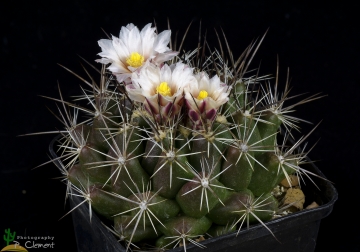 Torreycactus conothelos subs. garciae (Thelocactus garciae) Photo by: Peiffer Clement
Torreycactus conothelos subs. garciae (Thelocactus garciae) Photo by: Peiffer Clement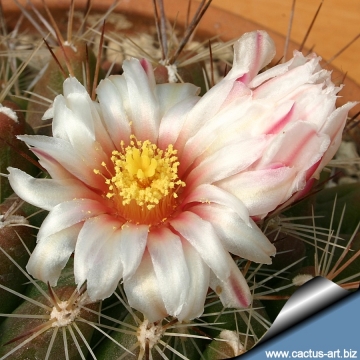 Torreycactus conothelos subs. garciae (Thelocactus garciae) Photo by: Cactus Art
Torreycactus conothelos subs. garciae (Thelocactus garciae) Photo by: Cactus Art Torreycactus conothelos subs. garciae (Thelocactus garciae) Photo by: Cactus Art
Torreycactus conothelos subs. garciae (Thelocactus garciae) Photo by: Cactus Art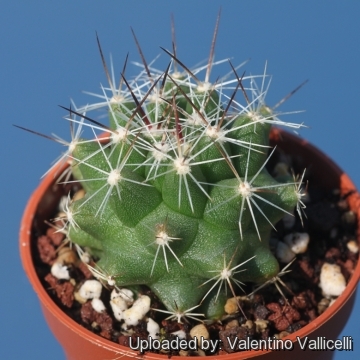 Torreycactus conothelos subs. garciae (Thelocactus garciae) Photo by: Valentino Vallicelli
Torreycactus conothelos subs. garciae (Thelocactus garciae) Photo by: Valentino Vallicelli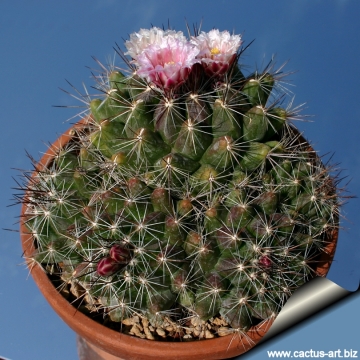 Torreycactus conothelos subs. garciae (Thelocactus garciae) Photo by: Cactus Art
Torreycactus conothelos subs. garciae (Thelocactus garciae) Photo by: Cactus Art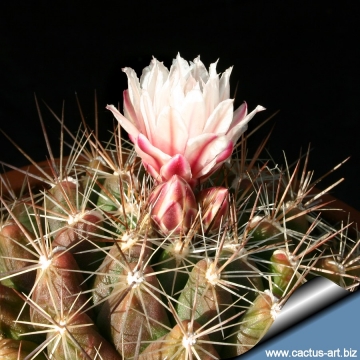 Torreycactus conothelos subs. garciae (Thelocactus garciae) Photo by: Cactus Art
Torreycactus conothelos subs. garciae (Thelocactus garciae) Photo by: Cactus Art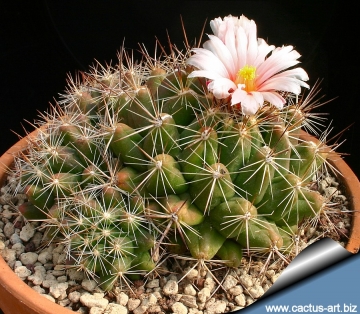 Torreycactus conothelos subs. garciae (Thelocactus garciae) Photo by: Cactus Art
Torreycactus conothelos subs. garciae (Thelocactus garciae) Photo by: Cactus ArtSend a photo of this plant.The gallery now contains thousands of pictures, however it is possible to do even more. We are, of course, seeking photos of species not yet shown in the gallery but not only that, we are also looking for better pictures than those already present.
Read More... Cultivation and Propagation: Thelocactus garciaeSN|15152]]SN|15152]] is easy to cultivate and recommended for any collection that needs lots of light with ample airflow.
Growth rate: It is a small growing, but easily flowering species. It offset from the base and can fill a 25 cm pot in just a few years given the best conditions.
Soils: It likes very porous standard cactus mix soil with little organic matter (peat, humus).
Repotting: Repotting every 2-3 years. It will need a pot with sufficient depth to allow the tap root. As it is especially prone to rot under-pot in a smaller container filled with very porous compost. Use pot with good drainage.
Watering: Water regularly in summer, but do not overwater (very wet-sensitively, especially in light of its succulent root system). Its roots are easily lost in pots that stay damp for any length of time. Keep dry with ample airflow in winter. In the rest period no high atmospheric humidity!! Care must be taken with watering as they tends to become swollen and untidy in growth habit if given too much water and shade.
Fertilization: During the growing season enrich the soil using a fertilizer rich in potassium and phosphorous, but poor in nitrogen, because this chemical element doesn’t help the development of succulent plants, making them too soft and full of water.
Hardiness: Reputedly sensitive to frost , but less so if kept on the dry side prior to, and during, cold weather (hardy to -7° C for short periods). However some warmth throughout the year will increase the grower's success (minimum 5° to 8°C during rest season).
Exposition: Outside bright sun, filtered sunlight or afternoon shade, inside it needs bright light, and some direct sun. Subject to sunburn if exposed to direct sun for too long. Tends to bronze in strong light, which encourages flowering and heavy wool and spine production.
Uses: It is an excellent plant for container growing. It always looks good and stays small. It look fine in a cold greenhouse and frame.
Pests & diseases: It may be attractive to a variety of insects, but plants in good condition should be nearly pest-free, particularly if they are grown in a mineral potting-mix, with good exposure and ventilation. Nonetheless, there are several pests to watch for:
- Red spiders: Sensitive to red spider mite. Overhead watering is helpful in controlling mites.
- Mealy bugs: Occasionally mealy bugs they develop aerial into the new growth among the wool with disfiguring results, but the worst types develop underground on the roots and are invisible except by their effects.
- Scales: Scales are rarely a problem.
- Rot: Rot it is only a minor problem with cacti if the plants are watered and “aired” correctly. If they are not, fungicides won't help all that much.
Reproduction: Nearly always from seed, since the plant rarely produces plantlets.

















